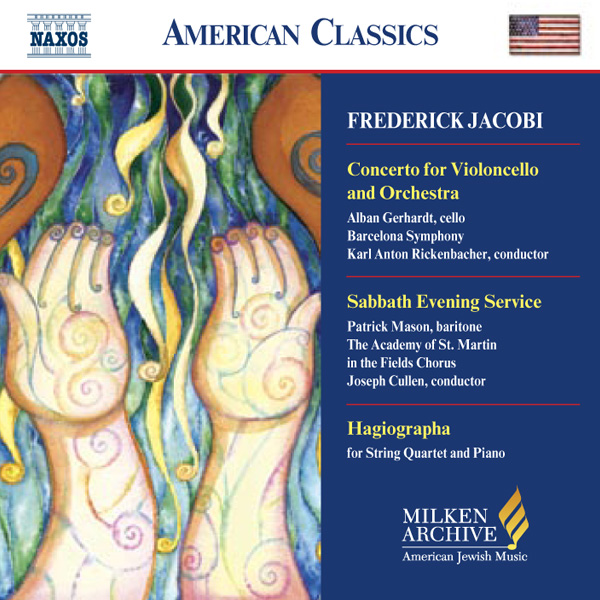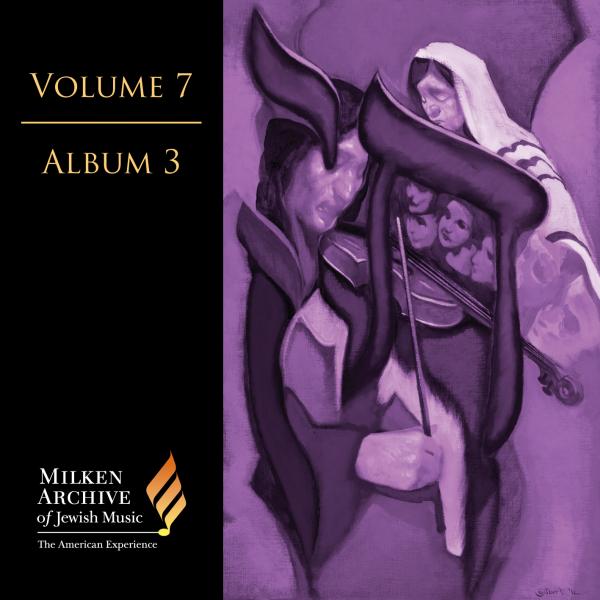Tracks
Liner Notes
New York’s Temple Emanu-El has had a long history of important musical endeavors. It was one of the first American congregations to embrace goals of western musical sophistication. It was among the first to commission artistic music for services—beyond functional hymns or adaptations from the operatic canon (although its organist and its choirmaster collaborated on editing and publishing one of the early important collections of synagogue hymns for Reform use). And it was probably the first American synagogue to commission serious 20th-century classical composers to write for its liturgy.
Founded in 1845 largely by families of the generations of German-Jewish immigrants who arrived in the United States during the first half of the 19th century, Emanu-El eventually became one of the most prestigious and most ubiquitously recognized Reform synagogues in America. By the 20th century, by virtue of a variety of factors—including the historically elite social and economic status of its lay leadership and of much of its earliest membership and, later, the cathedral-like aura of its present sanctuary (built 1926–30)—it acquired a popular perception in many quarters as the “flagship” congregation of the American Reform movement, at least in the eastern half of the country.
Emanu-El was the first congregation in America established initially as “Reform”—i.e., with some basic Reform innovations and departures from orthodox formats and tenets, in some respects based on urban German models that its founders probably never knew from personal experience—well before the official formulation and founding of an actual Reform movement in America. (Most if not all of the other American Reform synagogues founded by German-Jewish immigrants and their families in the first twenty or so years of that immigration period began more or less automatically as nominally orthodox, even if their congregants were not observant in other respects. But those congregations quickly instituted reforms to varying degrees and at various paces, which placed them squarely outside the realm of orthodoxy.) Yet unlike many classic Reform synagogues—especially beyond the Eastern Seaboard—Temple Emanu-El has nearly always had a dedicated cantor whom the synagogue recognized with that title, as distinct from an organist or choirmaster.
Lazare Saminsky (1882–1959), an established and respected composer in the general music world who was also one of the major personalities on the Jewish music scene in America following his immigration in 1920, became Temple Emanu-El’s music director in 1924. He ushered in an era of impressive musical accomplishments, liturgical creativity, and higher standards for American synagogue music in general. Born in the Czarist Empire, he belonged to the circle of musicians affiliated with the Gesellschaft für jüdische Volksmusik (Society for Jewish Folk Music) in St. Petersburg, whose mission was to foster the development of a Jewish national art music based on authentic Jewish musical materials. In America, too, he was an ardent advocate of serious new Judaically related music, secular and sacred. In addition to continuing to compose extensively himself both for the liturgy and for the concert stage, Saminsky used his Temple Emanu-El position to encourage many young composers to contribute their gifts to the music of the synagogue, to present innovative performances of Jewish music there, and, later, to establish and coordinate citywide Jewish choral festivals.
To realize his goals, Saminsky enlisted the support of Temple Emanu-El’s Choir Committee, although he always remained the prime mover and steward. In 1929, they established a program whose purpose was “purification and performance of new choral synagogue services by representative composers of the United States—and then possibly also by eminent Hebrew [Jewish] composers on the European continent,” in order to bring forth a “revival of Hebrew synagogue music in America.” That “revival” aspiration referred less to the excavation of old cantorial and other liturgical pieces than to reinvigorating synagogue music through commissions of new works. (Saminsky, however, was also interested in the history of Jewish liturgical music and had traveled extensively to conduct research into the chants and melodies of far-flung Jewish communities in such areas as Georgia, the Caucasus, Syria, and Palestine.) Saminsky wrote much of his own synagogue music under the Committee’s auspices, but beginning in the mid-1920s, he and the Choir Committee also sponsored performances of new Judaic works by such composers as Ernest Bloch and Joseph Achron, as well as biblical cantatas by Mussorgsky and Honegger, among others, and even arrangements of some of Saminsky’s ethnomusicological discoveries in the Near East and the Caucasus. The Temple Emanu-El program did not endure as long as the far more ambitious commissioning program later established by Cantor David Putterman at the Park Avenue Synagogue in New York, which was designed to operate permanently on an annual basis. Still, although it produced only a handful of new synagogue works compared with Cantor Putterman’s roster of more than eighty, and although it never achieved the same degree of national and even international recognition, Emanu-El’s earlier contributions to new music and its groundbreaking commissions should not be overlooked. Probably its most important commission of that period, apart from the Jacobi service, was a Sabbath eve service (1932) by Joseph Achron (1886-1943), who had been part of the Gesellschaft in St. Petersburg together with Saminsky.
Jacobi received the commission to compose a full-length Sabbath eve service for Temple Emanu-El under its Choir Committee’s auspices in 1930, and he wrote it during that winter in Switzerland after first working closely with Saminsky on correct accentuation of the Hebrew. The service was premiered at Temple Emanu-El in December 1931, conducted by Saminsky, with Cantor Moshe Rudinoff as soloist. It contains eight settings of Hebrew prayer texts found in the liturgy of all synagogues—although the texts were set as they appear in the Union Prayer Book, then the standard prayerbook of virtually all American Reform congregations. In addition to the settings excerpted for this recording, they include Tov l’hodot, Bar’khu, Sh’ma yisra’el, Va’anahnu, and a second Mi khamokha. The additional setting in English, O May the Words of My Mouth, was associated at that time primarily with Reform services.
Although the organ has always played a central role at Temple Emanu-El’s regular services, as it did in all classical Reform services, and although Saminsky was particularly interested in sophisticated organ music, this service was written to be sung a cappella. Jacobi underscored that instruction in his prefatory note to the published score, cautioning that the notated accompaniments, which are confined to doubling the vocal lines, are intended only as rehearsal aids. He added that much of his contrapuntal writing would be diluted by organ or other accompaniment, and the delicate character and clarity would be masked. Indeed, an entire service without organ sonorities must have sounded strange to Temple Emanu-El worshipers, especially at that time, as it would have in nearly all similar Reform synagogues of the day. But the a cappella provision should be understood in the context of Jacobi’s explanation that his artistic goal in this work was to seek “a return to the more simple style of the older Jewish ritual.” Indeed, although the music throughout is clearly original in melodic and harmonic content, there are echoes of premodern modality that evoke a common emotional (though not necessarily always historically accurate) perception of antiquity. Some of the harmonizations of cadences, in particular, might sound like references to the Dorian and Phrygian modes, but they are really based on independent Hebrew prayer modes and patterns; and those modal references are employed with artistic freedom and ingenuity, giving them a welcome freshness. The solo recitative passages are generally straightforward, but there are definite tinges of traditional cantorial ornamentation and melisma, treated with careful restraint. “Jacobi claimed that his goal had been a profound expression of feeling,” commented an unsigned New York Times review following the premiere, “[but] in this music there is light and strength as well as feeling.”
Unlike many other settings of the prayer text mi khamokha that begin typically with a jubilant statement, Jacobi’s (recorded here in the second of two alternate and independent versions included in the published score) opens in a spirit of solid and sustained tranquillity. Jacobi has interpreted the Israelites’ response to God’s parting of the Sea of Reeds in their escape from ancient Egypt as an expression of almost hushed awe and reverence for God rather than a boisterous celebration. The music becomes forceful, appropriately, at the words adonai yimlokh l’olam va’ed (The Lord shall reign for all eternity). The opening cantorial solo line of V’sham’ru is particularly effective in the absence of any choral or other accompaniment. Its resoluteness contrasts with the usual quiet mood of many other choral settings of the same text, but it includes reserved idiomatic cantorial ornaments and melismatic phrases clothed in a classical framework. Constituent motives of that exposition are developed subtly in the succeeding choral passages. The version of O May the Words of My Mouth recorded here is also the second of two alternate ones in the score, and it is most memorable for its luxurious choral sonorities. Jacobi’s elegant and stately Adon olam, the closing hymn of the service, avoids the superficial pompous character of many other popular settings that were found in various Reform-oriented hymnals of the 19th and early 20th centuries. And it is also free of the kitsch and, in some perspectives, even vulgarity that has become attached to the singing of this hymn in many late-20th–early-21st-century services, Reform or traditional—a fashion that probably could not even have been imagined in 1930. Here, we have tenderly passionate solo lines intertwined with gracious choral progressions, reflecting the simple dignity, majesty, and faith expressed in this medieval poem.
Lyrics
(Excerpts)
Sung in Hebrew and English
MI KHAMOKHA
Who is comparable among the mighty to You, O Lord?
Who can equal the magnificence of Your holiness?
Even to praise You inspires awe, You who perform wondrous deeds. Your children witnessed Your majesty; “This is my God,” they sang, and repeated,
“The Lord shall reign for all eternity.”
V'SHAM'RU
The children of Israel shall keep and guard the Sabbath and observe it throughout their generations as an eternal covenant. It is a sign between me and the children of Israel forever.
O MAY THE WORDS (II)
Sung in English
O may the words of my mouth and the meditation of my heart be acceptable in Thy sight. O Lord! my Rock and my Redeemer.
ADON OLAM
Lord of the world, who reigned even before form was created,
It was when His will brought everything into existence
That His name was proclaimed King.
And even should existence itself come to an end,
He, the Awesome One, would yet reign alone.
He was, He is, He shall always remain in splendor throughout eternity.
He is “One”—there is no second or other to be compared with Him.
He is without beginning and without end;
All power and dominion are His.
He is my God and my ever living Redeemer,
And the Rock upon whom I rely in time of distress and sorrow.
He is my banner and my refuge,
The portion in my cup—my cup of life
Whenever I call to Him.
I entrust my spirit unto His hand,
As I go to sleep and as I awake;
For my body remains with my spirit.
The Lord is with me: I do not fear.
Credits
Composer: Frederick JacobiPerformers: Academy of St. Martin-in-the-Fields Chorus; Joseph Cullen, Conductor; Patrick Mason, Baritone
Publisher: Frederick Jacobi
Translation from the Hebrew by Rabbi Morton M. Leifman

